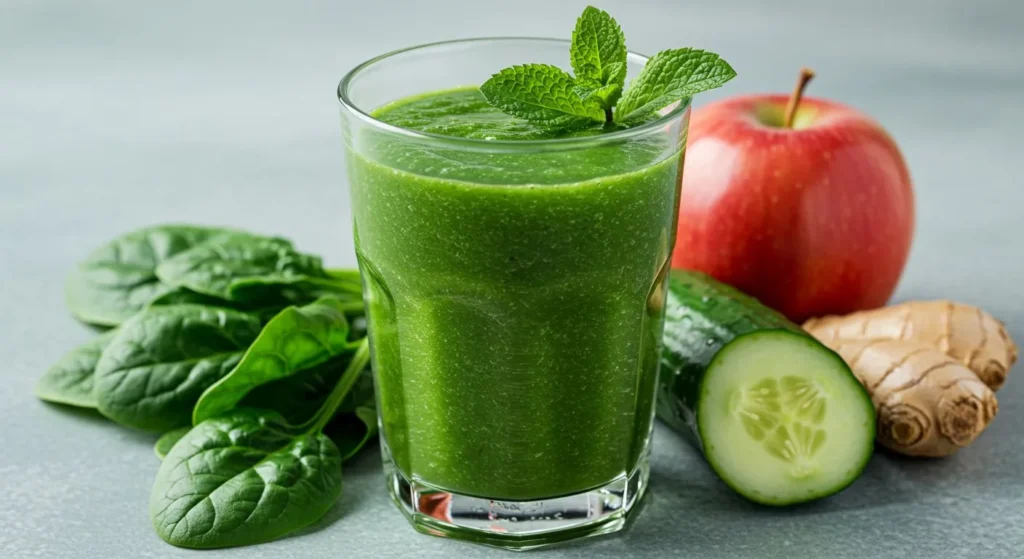
Table of Contents
Introduction
Have you ever watched in awe as hibachi chefs at Japanese steakhouses perform their mesmerizing cooking show, flipping spatulas, creating onion volcanoes, and ultimately producing the most flavorful fried rice you’ve ever tasted? That perfect combination of savory rice, tender chicken, and crisp broccoli has captivated food lovers worldwide. Today, we’re bringing that extraordinary hibachi experience right into your kitchen with our comprehensive guide to making authentic hibachi fried rice with chicken and broccoli.
This iconic Japanese-American dish combines the art of teppanyaki cooking (cooking on a flat iron griddle) with perfectly balanced flavors and textures. Whether you’re craving that restaurant experience at home, looking to impress dinner guests, or simply wanting to elevate your cooking skills, this recipe delivers all the sizzle, aroma, and flavor of professional hibachi without requiring special equipment or chef training.
In this guide, we’ll break down everything you need to know – from selecting the right ingredients and proper preparation techniques to mastering the high-heat cooking method that gives hibachi fried rice its distinctive taste. By the end of this article, you’ll have all the knowledge needed to create a restaurant-quality hibachi feast that rivals your favorite Japanese steakhouse.
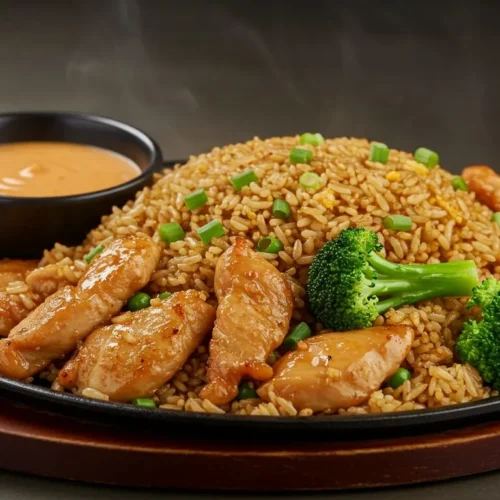
Perfect Hibachi Fried Rice with Chicken and Broccoli
Ingredients
- 4 cups cooked and chilled medium-grain rice
- 1 pound boneless skinless chicken breasts
- 3 cups fresh broccoli florets
- 3 tablespoons vegetable oil
- 2 tablespoons unsalted butter
- 3 tablespoons soy sauce
- 1 teaspoon sesame oil
- 2 eggs
- 1 medium white onion
- 3 cloves garlic
- 3 green onions
- 1 teaspoon garlic powder
- ½ teaspoon ground ginger
- ¼ teaspoon white pepper
- Salt and black pepper to taste
What Makes Hibachi Fried Rice Special?
Before diving into the recipe, let’s understand what makes hibachi fried rice unique:
The Cooking Surface: Traditional hibachi cooking uses a flat, extremely hot cooking surface called a “teppan.” At home, a well-seasoned cast iron skillet or carbon steel wok can replicate this high-heat cooking method.
The Performance: While the theatrical elements of flipping shrimp tails and creating flaming onion volcanoes are entertaining, the real magic lies in the cooking technique – high heat, quick movements, and precise timing.
The Ingredients: Authentic hibachi fried rice uses simple but quality ingredients. The rice must be cold and previously cooked, the vegetables freshly chopped, and the proteins perfectly prepared.
The Seasonings: The distinctive flavor comes from a careful balance of butter, soy sauce, and garlic, with subtle additions like sesame oil that elevate the dish without overwhelming it.
Essential Ingredients for Perfect Hibachi Fried Rice with Chicken and Broccoli
For the Fried Rice:
- 4 cups cooked and chilled medium-grain or short-grain rice (ideally day-old)
- 3 tablespoons vegetable oil, divided
- 2 tablespoons unsalted butter
- 1 medium white onion, finely diced
- 3 cloves garlic, minced
- 2 eggs, lightly beaten
- 3 tablespoons soy sauce (preferably low-sodium)
- 1 teaspoon sesame oil
- ¼ teaspoon white pepper
- 3 green onions, thinly sliced
- Salt to taste
For the Chicken:
- 1 pound boneless, skinless chicken breasts, cut into 1-inch pieces
- 1 tablespoon vegetable oil
- 2 tablespoons soy sauce
- 1 tablespoon unsalted butter
- 1 teaspoon garlic powder
- ½ teaspoon ground ginger
- Salt and black pepper to taste
For the Broccoli:
- 3 cups fresh broccoli florets
- 1 tablespoon vegetable oil
- 1 teaspoon minced garlic
- 2 tablespoons water
- Salt to taste
For the Hibachi Yum Yum Sauce (Optional):
- ½ cup mayonnaise
- 2 tablespoons ketchup
- 1 tablespoon rice vinegar
- 1 teaspoon sugar
- ½ teaspoon paprika
- ¼ teaspoon garlic powder
- Dash of cayenne pepper (optional)
Preparation Tips for Success
Rice Preparation
The foundation of exceptional hibachi fried rice is properly prepared rice. Follow these critical steps:
- Use the right rice: Medium-grain or short-grain rice works best as it has the ideal starch content for hibachi-style fried rice.
- Cook the rice ahead of time: For the perfect texture, cook your rice the day before or at least 4-6 hours in advance. This allows the rice to dry out slightly and firm up.
- Cooling process: After cooking, spread the rice on a baking sheet in a thin layer and let it cool completely before refrigerating. This prevents clumping and gives each grain that distinct hibachi restaurant texture.
- Breaking up clumps: Before cooking, gently break apart any clumps in your cold rice with your fingers to ensure even cooking.
Protein and Vegetable Preparation
Proper preparation of your chicken and broccoli is equally important:
- Uniform cutting: Cut your chicken into consistent 1-inch pieces to ensure even cooking.
- Broccoli sizing: Cut broccoli florets to uniform size – not too large (they won’t cook through) and not too small (they’ll overcook and become mushy).
- Mis en place: Have all ingredients prepped and arranged before you start cooking. Hibachi cooking moves quickly, and you won’t have time to chop vegetables once you begin.
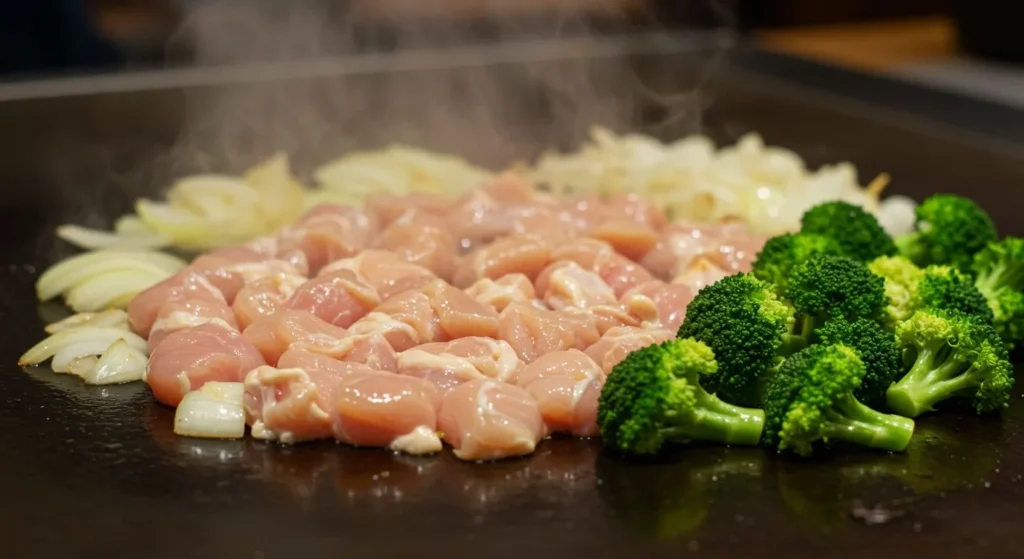
Step-by-Step Cooking Instructions
Cooking the Broccoli
- Heat 1 tablespoon of vegetable oil in a large wok or cast-iron skillet over medium-high heat until shimmering.
- Add broccoli florets and stir-fry for 1 minute.
- Add minced garlic and continue stir-frying for 30 seconds until fragrant.
- Pour in 2 tablespoons of water and immediately cover the pan with a lid to steam the broccoli for 2 minutes.
- Remove the lid, season with a pinch of salt, and stir-fry for another 30 seconds until the broccoli is tender-crisp with a vibrant green color.
- Transfer to a plate and set aside.
Cooking the Chicken
- In the same pan, add 1 tablespoon of vegetable oil and heat until shimmering.
- Add the chicken pieces in a single layer (work in batches if necessary to avoid overcrowding).
- Let the chicken cook undisturbed for 2 minutes to develop a golden-brown sear.
- Flip the pieces and cook for another 2 minutes.
- Add butter, soy sauce, garlic powder, and ground ginger. Stir-fry for 1-2 minutes until the chicken is cooked through (internal temperature of 165°F/74°C).
- Season with salt and pepper to taste.
- Transfer to a plate and set aside.
Making the Fried Rice
- In the same pan (add more oil if needed), add 2 tablespoons of vegetable oil and heat until shimmering.
- Add diced onions and stir-fry for 2-3 minutes until they become translucent.
- Add minced garlic and stir-fry for 30 seconds until fragrant.
- Push the onion and garlic mixture to one side of the pan and pour the beaten eggs into the empty space.
- Let the eggs cook for 30 seconds, then scramble them gently until they’re almost fully cooked but still slightly runny.
- Add the cold rice to the pan, breaking up any clumps. Stir-fry for 3-4 minutes, allowing the rice to heat through and begin to crisp slightly.
- Add butter and continue stir-frying until melted and incorporated.
- Pour soy sauce and sesame oil over the rice. Stir-fry for another 2 minutes until the rice is evenly coated and lightly caramelized.
- Season with white pepper and salt to taste.
Combining Everything Together
- Return the cooked chicken and broccoli to the pan with the fried rice.
- Gently fold all ingredients together to combine evenly.
- Stir-fry for an additional 1-2 minutes to ensure everything is hot.
- Add sliced green onions and stir to incorporate.
- Taste and adjust seasoning if needed.

Making the Yum Yum Sauce (Optional)
- In a small bowl, combine mayonnaise, ketchup, rice vinegar, sugar, paprika, garlic powder, and cayenne pepper (if using).
- Whisk until smooth and well combined.
- Refrigerate for at least 30 minutes before serving to allow flavors to meld.
Serving Suggestions
For an authentic hibachi restaurant experience:
- Serve the hibachi fried rice with chicken and broccoli on warmed plates.
- Place the yum yum sauce in a small ramekin on the side.
- Garnish with additional sliced green onions and a sprinkle of toasted sesame seeds.
- Accompany with traditional sides like ginger salad dressing over iceberg lettuce or clear onion soup.
Pro Tips for Authentic Hibachi Flavor
To truly capture that restaurant-quality taste, consider these professional tips:
- Heat management: Hibachi cooking relies on high heat. Make sure your pan is properly preheated before adding ingredients. A drop of water should sizzle and evaporate immediately when it hits the surface.
- Don’t overcrowd the pan: Cook in batches if necessary. Overcrowding leads to steaming rather than the searing that gives hibachi its characteristic flavor.
- Quality soy sauce matters: Use a good-quality Japanese soy sauce for authentic flavor. Low-sodium varieties give you better control over the final seasoning.
- The butter factor: Don’t skip the butter! It’s a key ingredient in American-style hibachi cooking and creates that distinctive rich flavor.
- Keep things moving: Constant motion prevents burning and ensures even cooking. Use a spatula to toss ingredients frequently.
- Clean as you go: Wipe down the cooking surface between components to prevent burnt bits from affecting the flavor of subsequent ingredients.
Common Mistakes to Avoid
Even experienced home cooks can fall prey to these common hibachi rice pitfalls:
- Using freshly cooked rice: This is perhaps the biggest mistake. Fresh rice contains too much moisture and will become mushy when stir-fried.
- Low heat cooking: Insufficient heat leads to soggy, steamed rice rather than the distinct, slightly crispy texture of hibachi rice.
- Overcrowding ingredients: Adding too much to the pan at once lowers the temperature and prevents proper searing.
- Over-seasoning: Authentic hibachi rice has a delicate balance of flavors. Too much soy sauce or sesame oil will overpower the dish.
- Overcooked vegetables: Broccoli should retain some crispness – overcooking results in mushy vegetables and loss of vibrant color.
Nutritional Information
Per serving (approximately 1½ cups, serves 4):
- Calories: 520
- Protein: 35g
- Carbohydrates: 45g
- Fat: 22g
- Fiber: 4g
- Sodium: 870mg
Variations and Substitutions
This recipe is wonderfully versatile. Here are some popular variations:
- Protein options: Substitute chicken with shrimp, steak, tofu, or a combination for a mixed hibachi experience.
- Vegetable additions: Add mushrooms, zucchini, carrots, or bean sprouts for extra nutrition and texture.
- Gluten-free adaptation: Use tamari instead of soy sauce to make this dish gluten-free.
- Healthier version: Use brown rice instead of white rice for additional fiber and nutrients, and reduce the butter by half.
- Spicy hibachi: Add sriracha or a teaspoon of chili oil to give your hibachi rice some heat.
 DINNER
DINNER LUNCH
LUNCH CAKE
CAKE BREAKFAST
BREAKFASTFor more amazing recipes, be sure to check out our other sections to explore a variety of ideas that will enrich your cooking experience. Each section offers its own unique flavors to ensure a delightful culinary journey:
- Easy and Quick Recipes: A collection of dishes that guarantee delicious meals with minimal effort and time.
- Healthy Recipes: Discover healthy and delicious options that fit your lifestyle.
- Desserts: A diverse selection of sweets that will add a special touch of sweetness to your table.
- Lunch Recipes: Tasty lunch ideas that you can easily prepare to delight your family.
- Dinner Recipes: Delicious and easy-to-make recipes that will make your dinner a memorable occasion.
Storage and Reheating
Hibachi fried rice stores well and often tastes even better the next day as flavors continue to develop:
- Refrigeration: Store leftovers in an airtight container for up to 3 days.
- Freezing: You can freeze hibachi fried rice for up to 2 months. Place in freezer-safe containers in single-serving portions.
- Reheating: For best results, reheat in a skillet over medium-high heat with a small amount of oil. Stir frequently until heated through. Add a small splash of water if the rice seems dry.
Frequently Asked Questions
Q: Can I use freshly cooked rice if I’m in a hurry? A: While day-old rice is ideal, you can use freshly cooked rice in a pinch. Cook it with slightly less water than usual, then spread it on a baking sheet and place it in the refrigerator for 30-60 minutes to cool and dry out somewhat.
Q: What’s the best cooking vessel to use at home? A: A carbon steel wok or a well-seasoned cast iron skillet works best for achieving the high heat needed for hibachi-style cooking.
Q: My rice keeps sticking to the pan. What am I doing wrong? A: Your pan may not be hot enough, or you might not be using enough oil. Make sure the pan is properly preheated and add a bit more oil if needed.
Q: Can I make this dish vegetarian? A: Absolutely! Substitute the chicken with firm tofu, tempeh, or additional vegetables. Use vegetable broth instead of chicken broth if called for in your rice preparation.
Q: Why is my rice mushy instead of having separate grains? A: This usually happens when using freshly cooked rice that hasn’t had time to dry out and firm up. Always use day-old rice for best results.
The History of Hibachi Cooking
Hibachi cooking has an interesting history that’s worth understanding to appreciate the dish fully:
The term “hibachi” actually refers to a traditional Japanese heating device – a small, portable brazier with an open top where charcoal is burned. In Japan, this was historically used for heating, not cooking.
What Americans know as “hibachi” is more accurately called “teppanyaki” – cooking on a flat iron griddle. This style of restaurant cooking began in Japan after World War II, specifically catering to American tourists who enjoyed watching their food being prepared.
The theatrical cooking style with spatula tricks, food flipping, and onion volcanoes was largely developed for entertainment value in American-based Japanese steakhouses during the 1960s and 1970s.
Today’s hibachi restaurants continue this tradition, combining excellent food with an engaging dining experience. Our recipe brings that experience home, focusing on the flavors and cooking techniques that make hibachi rice so beloved.
Conclusion
Mastering hibachi fried rice with chicken and broccoli at home is an achievable culinary adventure that rewards you with restaurant-quality results. By following the detailed steps in this guide – from properly preparing day-old rice to cooking with high heat and the right sequence – you can create an impressive meal that captures all the flavors of your favorite Japanese steakhouse.
The beauty of this dish lies in its balance: tender chicken, crisp-tender broccoli, and perfectly seasoned rice come together in a harmonious blend that satisfies both as comfort food and as an elevated dining experience. Once you’ve mastered the basic technique, you can easily customize the recipe to suit your taste preferences or dietary requirements.
Whether you’re cooking for a family dinner or hosting a special occasion, hibachi fried rice with chicken and broccoli is sure to impress. So heat up that skillet, gather your ingredients, and prepare to bring the excitement and flavors of the hibachi grill right to your own kitchen!

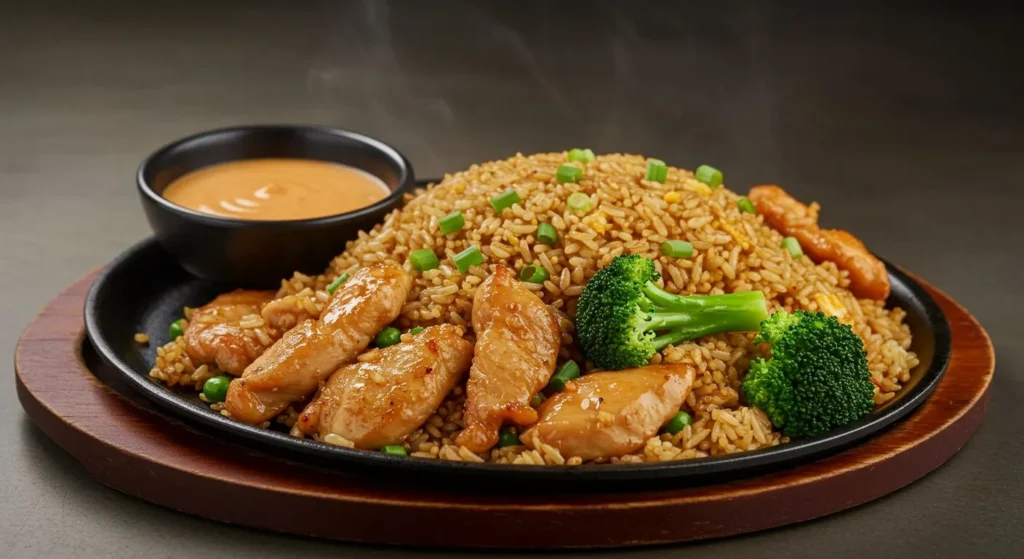

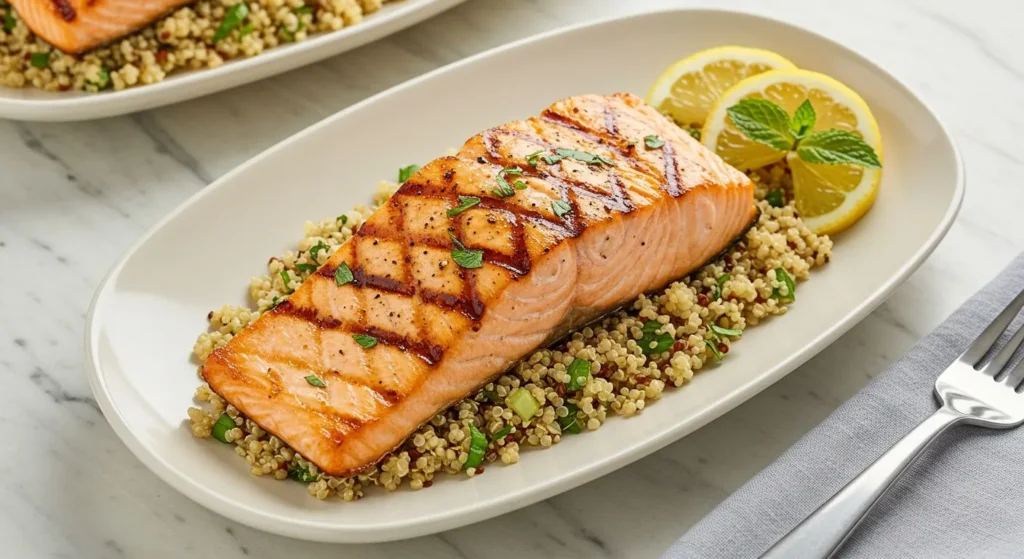
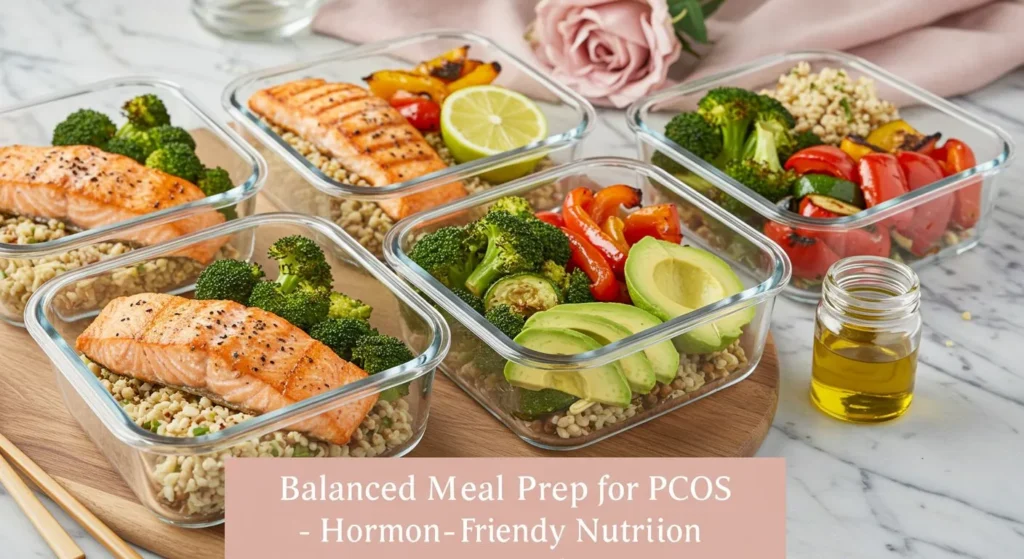
](https://jowelrecipes.com/wp-content/uploads/2025/05/compressed-image-1-30-1024x559.webp)
